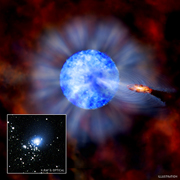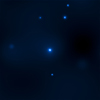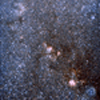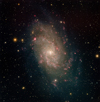Disclaimer: This material is being kept online for historical purposes. Though accurate at the time of publication, it is no longer being updated. The page may contain broken links or outdated information, and parts may not function in current web browsers. Visit chandra.si.edu for current information.
Solving the 26-year-old Puzzle of M33 X-7:
by Peter EdmondsOctober 18, 2007 ::
The announcement of M33 X-7 as the heaviest stellar black hole was made in a flash - the second that Nature's embargo expired - but the struggle to understand this record-breaking binary system lasted 26 years. That's long enough for the black hole and its companion to dance around each other more than 2500 times! Like many puzzles, it involved a few mistakes and a healthy dose of luck, as revealed in the story behind the discovery.
The detection of M33 X-7 was first reported in 1981, by the Einstein observatory - an early X-ray telescope - and it was immediately identified as being bright and variable. This variability was explained by an eclipse occuring in a binary system every 1.7 days, although later observations with other X-ray telescopes showed that the orbital period was really 3.5 days (people might joke about a factor of 2 being negligible in the field of astronomy, but orbital periods can actually be determined to incredible accuracy with good data). So, the first piece of the puzzle was firmly in place: M33 X-7 was known to be an eclipsing X-ray binary with a measured period. But, this wasn't likely to have set any astronomer's hearts racing, especially without an optical counterpart to nail down what the system contained.
In 1999 the early X-ray data was also used to claim that M33 X-7 pulsed every 0.3 seconds. The evidence wasn't overwhelming, but it was strong enough for a group of smart - but unlucky - astronomers to infer that M33 X-7 was a rapidly spinning neutron star, not a black hole. In astronomical research, just as in other research fields, evidence that is just at the limit of believability can be extremely tantalizing, because it often turns out to be true. However, this wasn't the case here. Later, more sensitive observations were never able to confirm the pulsation. In effect, an ill-fitting piece had been jammed into the M33 X-7 puzzle, giving a misleading picture.
This misleading picture remained in place for several years until much more powerful X-ray telescopes went into orbit, NASA's Chandra X-ray Observatory and XMM-Newton from the European Space Agency. In 2004 a team led by Wolfgang Pietsch from the Max Planck Institute for Extraterrestrial Physics used these telescopes to study M33 X-7. They failed to find pulsations, so that misleading piece of evidence was removed. They did, however, add a crucial new piece, the optical detection of a hot massive companion star to M33 X-7. Based on the properties of this star and other results, including the lack of pulsations, Pietsch et al. argued that M33 X-7 might be a black hole. If so, it would be the first eclipsing X-ray binary containing a black hole, making it attractive for optical follow-up study. A big optical telescope like Gemini would be needed for this work and time on such telescopes is hard to come by. There remained a chance that M33 X-7 was only a neutron star, not a black hole, and eclipsing neutron star binaries aren't as sexy, since they have been seen before. Compelling evidence for a black hole was needed before optical astronomers would go after it.
The crucial breakthrough came with the approval of 16 days of Chandra time to observe M33, in a project called the Chandra ACIS survey of M33 (ChASeM33). This project, led by Manami Sasaki of the Harvard-Smithsonian Center for Astrophysics (CfA), was the longest observation ever made of an external galaxy. The competition for observing time on a telescope like Chandra is intense - only the fittest proposals survive the tough selection process and get awarded this much time.
As a nearby spiral galaxy, M33 is too big to fit inside the field-of-view of Chandra, so multiple, overlapping pointings had to be used to observe the full galaxy. M33 X-7 fell inside many of the different fields, for a total of about 5 days of observing time. These observations were used to observe, for the first time, M33 X-7 going into and out of eclipse. Combining this information with earlier X-ray observations from other satellites along with data from the Hubble Space telescope, Wolfgang Pietsch and colleagues showed in a paper published in 2006 that the mass of M33 X-7 had to exceed 9 times the mass of the Sun. That's about 3 times as massive as neutron stars are expected to get, making it a definite black hole, and convincing Jerry Orosz, of San Diego State University, and Jeff McClintock, of CfA, that Gemini was needed to measure just how massive this black hole was. When they made their observations the last piece of the puzzle was filled in and the resulting picture ended up looking something like this.
The crucial optical follow-up may never have happened without the deep Chandra observations of ChASeM33. Luck played a key role in piecing together the M33 X-7 puzzle, since this object was a relatively minor part of the successful proposal. The astronomers on the Time Assignment Committee (TAC), who decide which proposals get observing time, were unlikely to accept such a large proposal based merely on the potential that a particular binary would be an interesting, high-mass system, even if bribes were attempted!
So, how did such a large proposal get time? Clearly, no-one just woke up on the day proposals were due and suddenly thought "hey, let's go for a huge amount of time on Chandra to look at M33: that's never been done before!" For a start, a proposal like this takes a lot of time and effort. A big team with diverse interests is needed, since there's a lot of science to be done with deep observations of an entire galaxy. Back in 2005 when the TAC met, M33 X-7 was just one of a bunch of potentially interesting X-ray sources in M33, and there was also keen interest in studying other sources of X-ray emission, such as supernova remnants and diffuse hot gas. Some of these other science results have already been accepted in journals and more will undoubtedly appear. Nevertheless, thanks to serendipity and 26 years of study, M33 X-7 might turn out to be the "star" of this galaxy.
References:
Dubus, G. et al. 1999, MNRAS, 302, 731
Long, K.S. et al. 1981, ApJ, 246, L61
Orosz, J.A. et al. 2007, Nature, 449, 872
Pietsch, W et al. 2006, ApJ, 646, 420
Pietsch, W et al. 2004, A&A, 402, 457
Disclaimer: This material is being kept online for historical purposes. Though accurate at the time of publication, it is no longer being updated. The page may contain broken links or outdated information, and parts may not function in current web browsers. Visit chandra.si.edu for current information.









